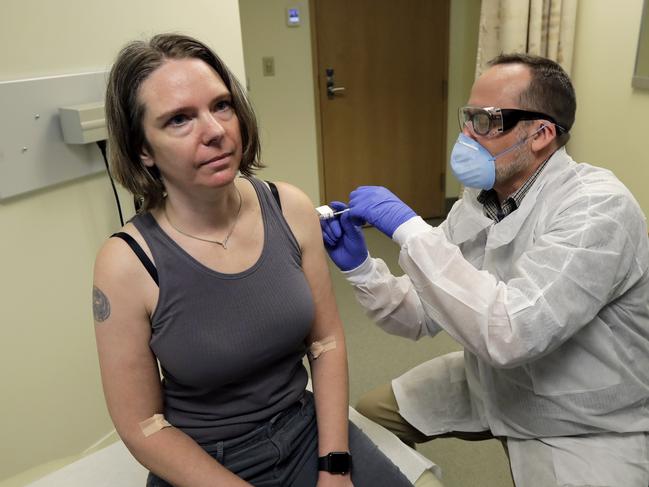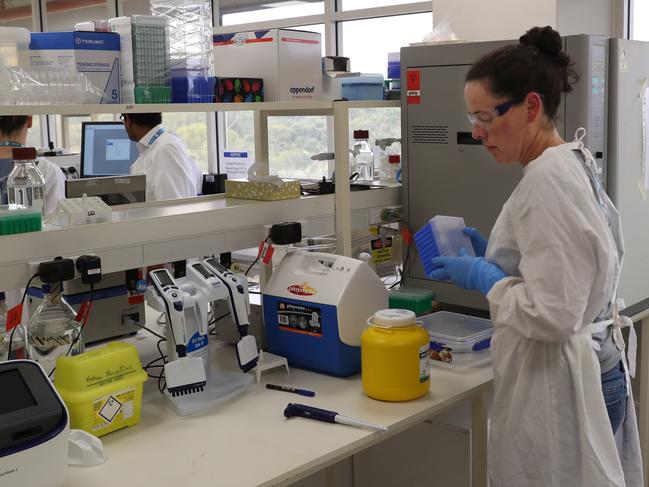Why CSIRO scientists cannot answer the killer COVID-19 question
Australia’s CSIRO has identified six different clusters of COVID-19 circulating worldwide but there is one killer question they are still scrambling to answer.

- Elective surgery waiting lists to blow out amid COVID-19
- Australia ‘on the cusp’ of virus breakthrough
A gaping hole in COVID-19 data is preventing researchers answering the killer question – are some genetic variants of the virus more deadly than others?
Australian researchers who have analysed the first 181 genome sequences of the virus have revealed it has evolved into six genetically distinct clusters in different parts of the world.
The head of the CSIRO’s Dangerous Pathogens Team Professor Seshadri Vasan said what his team lack was the metadata to work out if some of these clusters were producing more severe disease than others.
All that is required to plug the information gap is for doctors to provide researchers with de-identified information to show if the patients treated had mild, moderate or severe COVID-19 disease and if they survived.
Information on the patient’s age and whether they had any other illnesses like diabetes or respiratory disease is also needed.
“To enable this, we are calling on the international research community to share de-identified details of case severity and outcome, and other relevant metadata such as comorbidities and smoking status, alongside the genomic sequences of the virus,” Professor Vasan said.
“Whatever genetic sequences were uploaded by Australian colleagues have come from a hospital reference laboratory and they should still have access to patient notes, so there is nothing that stops making that information available.”
Scientists know up to 60 per cent of people who have COVID-19 experience no symptoms at all while others become very ill and some die.
What we do not know is if it is the genetic make up of the person which means they experience the disease in a more severe form or if it is the strain of the virus that is more deadly, or both.
“When you map how the virus is mutating, if you had de-identified patient data you may be able to work out if more severe disease in a particular area is likely due to the virus but we can’t do that because we are missing metadata,” Professor Vasan said.

The SARS-CoV-2 virus which causes COVID-19 is continuing to evolve since it first appeared in Wuhan, China, late last year and 10,245 genetic sequences have been published as of Monday.
Laboratories worldwide who have sequenced different samples of the virus are sending them to a central data base called GISAID.
In a new research paper published in the peer-reviewed journal Transboundary and Emerging Diseases, Vasan and colleagues report on the first 181 published genetic sequences of the virus using bioinformatics to pinpoint differences and identify different clusters.
The team began the exercise to make sure that scientists racing to develop therapies and vaccines against this virus were using the right strains, those which were the most virulent and closest to the strains circulating in the community.
It found among the Australian strains, one called Australia/Sydney2 as a less optimal target for testing for a COVID-19 vaccine.
However, the Australia/VIC01, Australia/VIC02 and Australia/SA01 were better strains of the virus to use when testing vaccines.
MORE NEWS
Harry and Meghan find $16m ‘rental’ in LA
Australia’s curve flattens amid calls for China inquiry
Urban rocks global gig as Beyonce delivers grim message
The USA/WA1 would also “be a good choice due to its central location, likely ability to represent especially the newly emerging clusters”, the study found.
“Nothing at the moment is seriously concerning us in terms of the choices (of the strains being used in vaccine tests),” Professor Vasan, who is running the world’s first multi-vaccine animal efficacy studies, said.
Although the virus is mutating at a moderate pace the researchers said “at this time, we do not expect it will affect the development and evaluation of COVID-19 vaccines, therapies and diagnostics, but it is important information to monitor as preclinical and clinical studies progress”.
Professor Vasan added the GISAID data base on COVID-19 now has 10245 sequences and 902 of these were from Australia.

“Typically sequences within a family or a close community are identical because this is a relatively slow mutating RNA virus with a proof reading capacity,” he said.
Out of the first 4995 sequences published on GISAID, 388 were uploaded from Australia and Professor Vasan said “some mutations are minor and/or have no functional consequence; and for the remaining 162 protein-changing mutations we are unable to determine clinical/epidemiological impacts without metadata.”
For instance, only 14 out of the 388 have clinical annotations; the rest are either annotated as unknown or not at all.
Out of the 162 significant mutations in the virus in Australia 86 occurred in NSW, 74 Vic, 40 QLD, and 31 WA.
